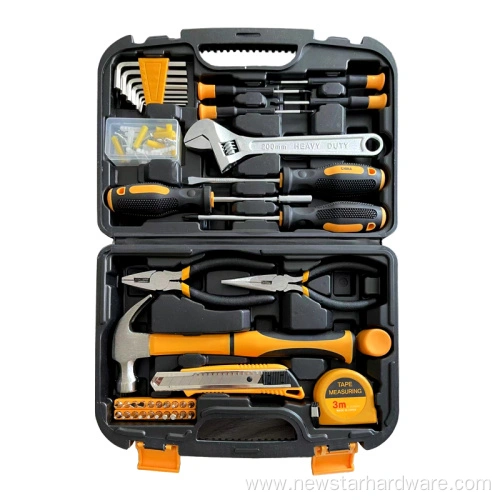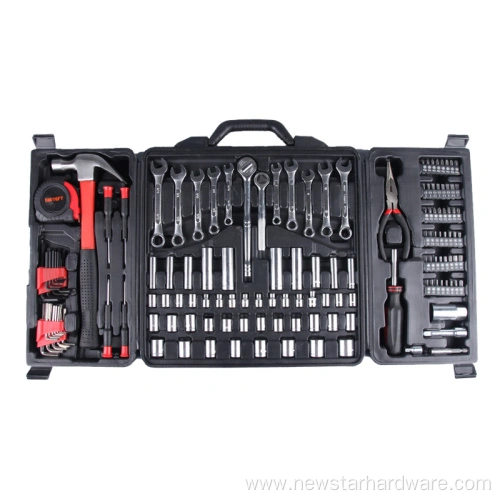Introduction
For DIY enthusiasts delving into the world of auto body repair, having the right tools is essential. The journey from a novice to a skilled technician is significantly influenced by the quality and comprehensiveness of one's toolset. Whether you're fixing minor dents or undertaking a complete restoration, understanding and acquiring the proper Auto Repair Tools is the cornerstone of successful projects. It not only enhances the efficiency of the repair process but also ensures safety and precision in every task.
![auto body repair tools list auto body repair tools list]()
The Importance of Quality Auto Body Repair Tools
Embarking on auto body repairs without the appropriate tools is akin to navigating without a map. Quality tools are not just about getting the job done; they are about doing it right. They provide the precision needed to restore vehicles to their former glory. Moreover, investing in high-grade tools ensures durability, reducing the long-term costs associated with replacements and inefficiencies. As we delve deeper into the essential tools required, it's imperative to recognize that each tool serves a specific purpose, contributing to the overall success of your repair endeavors.
Essential Hand Tools for Auto Body Repair
Wrenches and Socket Sets
At the heart of any auto repair task lies the fundamental use of wrenches and socket sets. These tools are indispensable for loosening and tightening nuts and bolts of various sizes. A complete set, including both metric and SAE sizes, is essential to accommodate the diverse range of vehicles and components. High-quality wrenches provide the leverage and torque needed to handle stubborn fasteners without stripping or damaging them.
Screwdrivers and Pliers
Screwdrivers and pliers are the unsung heroes of auto body repair. A comprehensive set of screwdrivers, including flathead, Phillips, Torx, and hex types, allows for versatility in tackling various screws and bolts. Pliers, such as locking pliers, needle-nose pliers, and side cutters, are crucial for gripping, bending, and cutting wires or small components. Their ergonomic design ensures comfort during prolonged use, reducing hand fatigue.
Hammers and Mallets
In auto body repair, hammers are not merely for driving nails. Specialized hammers, like ball-peen, cross-peen, and dead-blow hammers, are essential for shaping metal, removing dents, and performing precise bodywork adjustments. Mallets with soft faces prevent damage to surfaces, allowing for gentle persuasion of components into place without marring finishes.
Measuring and Marking Tools
Accuracy is paramount in auto body repair, making measuring and marking tools indispensable. Tools like tape measures, calipers, and marking gauges ensure precise measurements and alignments. They help in cutting materials to exact dimensions and aligning components correctly, which is vital for both the aesthetics and functionality of the vehicle.
Power Tools That Elevate Your Work
Air Compressors
An air compressor is the heartbeat of many auto body shops. It powers a range of pneumatic tools, including spray guns, impact wrenches, and sanders. When selecting an air compressor, consider factors like tank size, pressure output, and airflow (CFM) to ensure it meets the demands of your tools. A compressor with a larger tank and higher CFM rating provides consistent airflow, which is crucial for tasks like painting and sanding.
Sanders and Grinders
Achieving a smooth surface is essential before painting or finishing. Sanders, such as dual-action (DA) sanders, orbital sanders, and belt sanders, help in leveling surfaces, removing old paint, and preparing panels for refinishing. Grinders are utilized for cutting through metal panels, removing rust, and shaping metal components. Investing in quality sanders and grinders ensures efficiency and a professional finish.
Drills and Drill Bits
Drills are essential for creating holes for fasteners or removing spot welds. Cordless drills offer mobility, whereas corded drills provide consistent power for heavy-duty tasks. Having a variety of drill bits, including cobalt and titanium-coated bits, allows you to work with different materials like metal, plastic, and composites. Precision in drilling ensures components are securely fastened and aligned.
Paint Sprayers
A professional paint job sets your work apart, and quality paint sprayers are pivotal in achieving this. High Volume Low Pressure (HVLP) sprayers are commonly used due to their efficiency and precision. They minimize overspray and waste, providing a smooth, even coat of paint. Understanding the adjustments for fluid control, air pressure, and spray patterns is crucial for optimal results.
Specialized Auto Body Tools
Dent Pullers and Slide Hammers
Dent repair is a fundamental aspect of auto body work. Dent pullers and slide hammers are instrumental in removing dents without damaging the surrounding paint. Suction cup dent pullers are ideal for larger, shallow dents, while slide hammers are used for more stubborn dents. These tools allow for the application of controlled force, pulling the dented metal back into place.
Auto Body Dollies and Spoons
Dollies and spoons are essential for shaping and smoothing metal panels. They come in various shapes like heel, toe, and comma dollies, each designed for specific contours and curves. By using a hammer in conjunction with a dolly, you can efficiently remove imperfections and restore the panel's original shape. Mastery of these tools elevates the quality of your workmanship.
Shrinking and Stretching Tools
Metal can stretch or shrink during repairs, leading to misalignments. Shrinking hammers and stretching tools help in correcting these issues. Shrinking hammers have serrated faces that gather stretched metal, while stretching tools expand metal surfaces to eliminate gaps. These tools are vital for ensuring panels fit seamlessly, maintaining structural integrity and aesthetics.
Panel Beating Tools
Panel beating involves restoring damaged panels to their original form. Specialized panel beating kits include a variety of hammers and dollies tailored for specific tasks. Using these tools requires skill and finesse, as improper use can worsen damage. They are essential for repairing vintage or custom cars where replacement panels are not readily available.
Welding Equipment for Structural Repairs
MIG Welders
Metal Inert Gas (MIG) welding is prevalent in auto body repair due to its versatility and ease of use. MIG welders are ideal for welding thin metals common in vehicle bodies. They provide strong, clean welds essential for structural integrity. Understanding settings like voltage, wire feed speed, and shielding gas flow is crucial for achieving quality welds.
Spot Welders
Spot welders are used to join overlapping metal sheets, replicating factory welds. They are essential for tasks like replacing body panels or repairing frames. Spot welding provides strong, discrete welds that require minimal finishing. Investing in a quality spot welder enhances efficiency and the professional appearance of repairs.
Safety Equipment: Protecting Yourself
Personal Protective Equipment (PPE)
Safety should never be an afterthought. Personal Protective Equipment includes items like coveralls, safety boots, and ear protection. They shield you from hazards like flying debris, loud noises, and harmful substances. Investing in quality PPE ensures comfort and prolonged protection during extended work periods.
Safety Glasses and Gloves
Eye injuries are prevalent in auto repair due to flying particles. Safety glasses or goggles are non-negotiable. Gloves protect your hands from cuts, burns, and chemical exposures. Different tasks may require specific glove types, like nitrile gloves for chemicals or leather gloves for welding. They enhance grip and dexterity while providing protection.
Respirators
Exposure to dust, fumes, and paint vapors can have long-term health effects. Respirators filter out harmful particles and gases, safeguarding your respiratory system. Depending on the task, you may need a simple dust mask or a more advanced respirator with cartridges for specific chemicals. Ensuring a proper fit enhances their effectiveness.
Conclusion
Mastering auto body repair is a blend of skill, knowledge, and having the right tools. For DIY enthusiasts, investing in quality Auto Repair Tools is a stepping stone to achieving professional-level results. Each tool, from the humble wrench to the sophisticated welder, plays a pivotal role in the repair process. By equipping yourself adequately, you not only enhance the quality of your work but also ensure safety and efficiency in your projects. As you continue to build your toolset, remember that the best outcomes are a result of both excellent tools and the dedication to honing your craft.
![auto body repair tools auto body repair tools]()
Frequently Asked Questions
1. What are the most essential auto body repair tools for beginners?
For beginners, starting with basic hand tools like wrenches, screwdrivers, and pliers is essential. Adding specialized tools like dent pullers and a quality sanding block can significantly enhance your ability to perform common repairs.
2. Why is an air compressor important in auto body repair?
An air compressor powers pneumatic tools such as spray guns, sanders, and impact wrenches. It provides the consistent airflow needed for these tools to operate efficiently, making it a crucial component in auto body work.
3. How do I choose the right paint sprayer for my projects?
Selecting the right paint sprayer depends on factors like the type of paint, the size of the project, and your experience level. HVLP sprayers are recommended for their efficiency and control, ideal for achieving a professional finish.
4. What safety equipment should I prioritize when starting?
Prioritize safety glasses, gloves, and respiratory protection. These items protect you from common hazards like flying debris, chemical exposures, and harmful fumes encountered during repair tasks.
5. Can I perform welding tasks without prior experience?
Welding requires training and practice to perform safely and effectively. It's advisable to seek guidance or take a course to learn proper techniques before attempting welding repairs on your own.
6. How often should I maintain or replace my tools?
Regular maintenance, such as cleaning and proper storage, can extend the life of your tools. Replace tools when they show signs of wear that could affect performance or safety, like cracked handles or worn-out edges.
7. Where can I find quality auto repair tools?
Quality auto repair tools can be found at specialized retailers, online stores, or suppliers like Auto Repair Tools. Investing in reputable brands ensures durability and performance in your repair tasks.




















